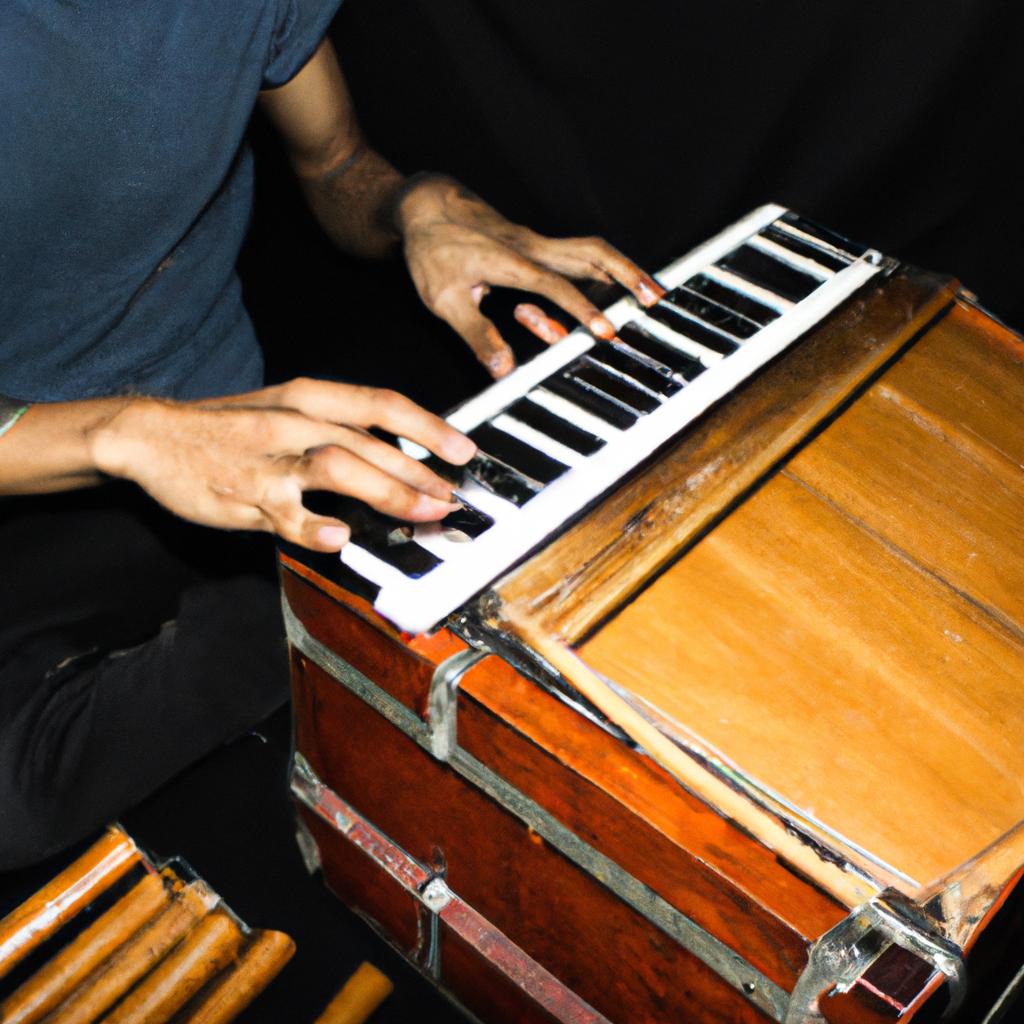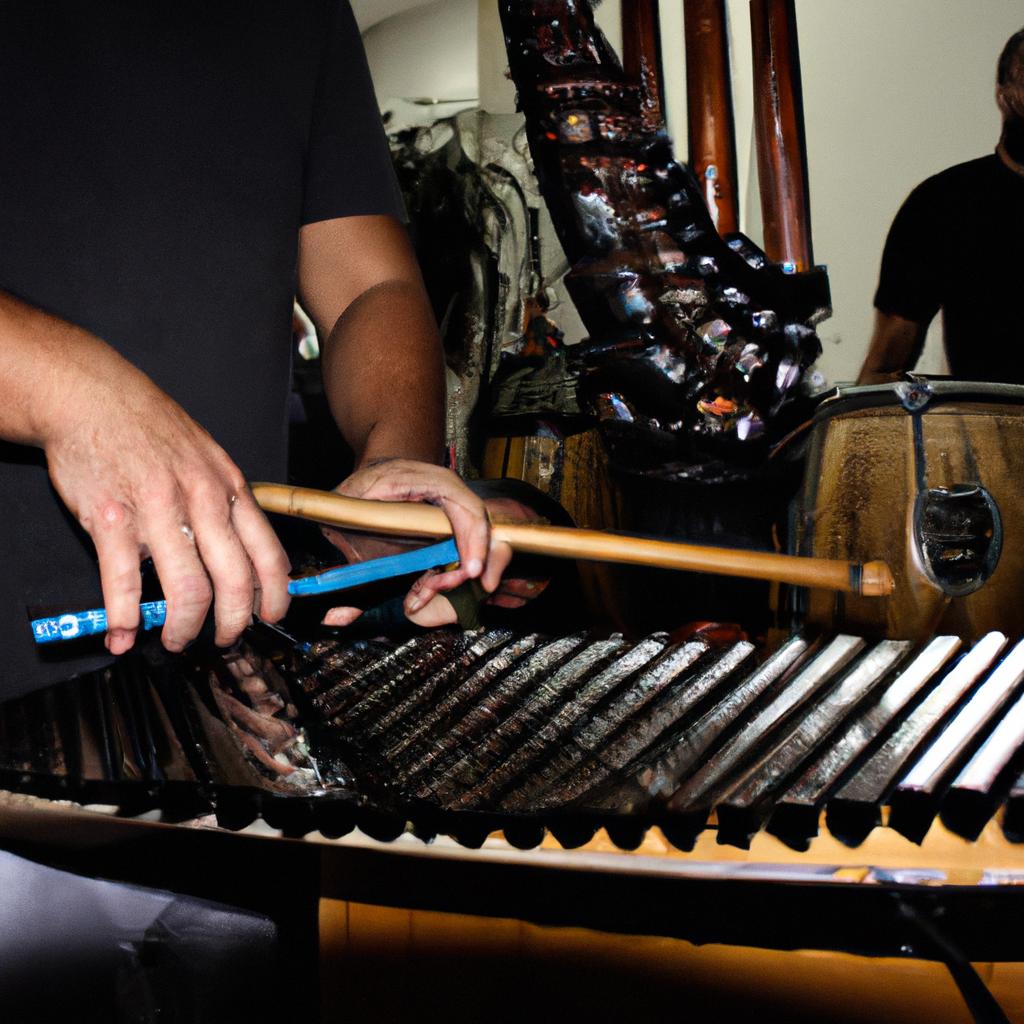Artists in Music: The Vibrant World of Arts and Entertainment
Artists in the realm of music exist within a vibrant and captivating world of arts and entertainment. This diverse community comprises individuals who possess exceptional talent, creativity, and passion for their craft. Through their unique expressions, artists have the power to evoke emotions, inspire change, and provide profound experiences for both themselves and audiences alike. For instance, consider the case study of renowned singer-songwriter Taylor Swift whose career has not only showcased her musical prowess but also highlighted the transformative impact that artists can have on society.
The dynamic nature of the arts industry offers numerous avenues for musicians to explore their artistic visions and connect with audiences on multiple levels. Musicians are masters at combining various elements such as melody, rhythm, lyrics, instrumentation, and performance techniques to create sonic landscapes that resonate deeply with listeners. These creative endeavors enable artists to communicate narratives or convey messages through their compositions effectively. Whether it is expressing personal reflections or addressing social issues, musicians often serve as cultural commentators who document contemporary life through the universal language of music.
In this article, we will delve into the multifaceted dimensions of the music industry by exploring the lives and contributions of artists across different genres. By examining their artistic processes, societal impacts, and navigating challenges within an ever-evolving landscape, we aim to gain a deeper understanding of the transformative power of music and its significance in our lives.
We will begin by examining the creative process of musicians, shedding light on how they harness their talents and inspirations to craft their unique sound. Through interviews with artists from various genres, we will explore their sources of inspiration, songwriting techniques, and the role that collaboration plays in their creative endeavors. By delving into these aspects, readers will gain insight into the inner workings of an artist’s mind and understand the dedication and hard work required to bring their visions to life.
Additionally, we will analyze the societal impacts of music and how artists can become catalysts for change. Music has always had a profound influence on society, serving as a platform for expressing emotions, challenging norms, and advocating for social justice. We will highlight artists who have used their platforms to address important issues such as inequality, discrimination, mental health, and environmental sustainability. By showcasing these examples, we hope to inspire readers to recognize the potential for music to ignite conversations and foster positive change within communities.
Navigating the music industry can be both exhilarating and daunting for artists. There are numerous challenges they face along their journey – from finding opportunities to showcase their talent to dealing with record labels or managing their own careers independently. We will delve into these obstacles and discuss strategies employed by successful musicians to overcome them. By offering practical advice and insights from industry professionals, aspiring musicians can gain valuable knowledge on how to navigate this competitive landscape while staying true to their artistic vision.
Overall, this article aims to celebrate the creativity and passion that drives artists in the realm of music. It seeks to shed light on the power of music as an art form that transcends boundaries and connects people from diverse backgrounds. Whether you are an avid fan or aspiring musician yourself, this exploration into the world of music will provide you with a deeper appreciation for its impact on our lives and inspire you to embrace the transformative power of music.
The Evolution of Artistic Expression in Music
Throughout history, the world of music has witnessed a remarkable evolution in artistic expression. From ancient civilizations to modern times, musicians have continuously pushed boundaries and revolutionized their craft. One such example is the rise of jazz music in the early 20th century, which exemplified the fusion of traditional African rhythms with Western musical elements.
To understand this evolution, it is essential to delve into key factors that have influenced artistic expression in music:
-
Technological advancements: The advent of recording technologies allowed musicians to reach wider audiences and experiment with new sounds. This led to the development of various genres like rock ‘n’ roll and electronic music, where artists utilized synthesizers and other innovative instruments to create unique sonic landscapes.
-
Sociocultural context: Artists often draw inspiration from their surroundings, reflecting societal issues or cultural movements through their music. For instance, during the civil rights movement in the United States, soul and funk music emerged as powerful tools for social commentary and empowerment.
-
Cross-cultural influences: With globalization, different cultures started influencing one another’s musical traditions. This cross-pollination gave birth to hybrid genres like reggae, fusing Jamaican folk rhythms with American blues elements.
-
Individual creativity: Musicians constantly strive to break away from conventional norms by exploring unconventional techniques or introducing new instruments into their compositions. This individuality allows for fresh perspectives and pushes the boundaries of what is considered “mainstream” within the industry.
In order to fully grasp the richness and diversity that exists within artistic expression in music, it is crucial to explore various genres and styles that have emerged over time. By examining these distinct pathways taken by musicians throughout history, we can gain a deeper understanding of how they continue to shape our contemporary musical landscape without skipping a beat
Exploring Different Genres and Styles
Building upon the rich history of artistic expression in music, it is essential to delve into the diverse range of genres and styles that have emerged throughout time. By exploring various musical landscapes, we gain a deeper appreciation for the creativity and innovation displayed by artists across different eras. In this section, we will examine notable examples from distinct genres while highlighting their unique characteristics.
Case Study:
One compelling example lies within the realm of jazz fusion – a genre that seamlessly combines elements of jazz with other musical styles. Take, for instance, the iconic album “Bitches Brew” released by Miles Davis in 1970. This groundbreaking record merged traditional jazz instrumentation with rock influences, introducing an entirely new sonic landscape to listeners worldwide. Through its experimental nature and improvisational approach, Davis pushed boundaries and challenged conventions, ultimately reshaping perceptions of what could be achieved within the realm of jazz.
- Awe-inspiring vocal harmonies that transport listeners to ethereal realms.
- Captivating melodies that evoke profound emotions.
- Dynamic rhythms that compel bodies to sway instinctively.
- Soul-stirring lyrics addressing universal themes of love, loss, and personal growth.
Table (3 columns x 4 rows):
| Genre | Characteristics | Notable Artists |
|---|---|---|
| Classical | Orchestral arrangements | Ludwig van Beethoven |
| Hip-hop | Emphasis on rhythm and wordplay | Kendrick Lamar |
| Reggae | Laid-back grooves | Bob Marley |
| Electronic Dance | Energetic beats | Daft Punk |
In examining these diverse genres and their respective characteristics, we witness the power of music to evoke a wide range of emotions. Whether it be the ethereal vocal harmonies that transport us to otherworldly realms or the captivating melodies that stir our souls, each genre offers its own unique experience for listeners.
Moving forward, we will now explore how technology has revolutionized the artistic process and brought about new avenues for creative expression. By harnessing the capabilities offered by modern advancements, artists have been able to push boundaries even further, resulting in an ever-evolving landscape of musical artistry.
The Impact of Technology on the Artistic Process
Continuing our exploration of the vibrant world of arts and entertainment, we now delve into the profound impact that technology has had on the artistic process. To illustrate this point, let us consider a hypothetical case study involving an up-and-coming musician named Alex.
Alex is a talented singer-songwriter who embarked on their musical journey by learning to play various instruments and writing heartfelt lyrics. However, with advancements in technology, Alex discovered new ways to enhance their music production. They began experimenting with digital audio workstations (DAWs), allowing them to record, edit, and mix tracks without needing expensive studio equipment or professional assistance.
The integration of technology into the artistic process has revolutionized the way musicians create and share their music. Here are some key aspects highlighting its impact:
-
Accessibility:
- Technology has made it easier for aspiring artists to access tools and resources that were once limited to professionals.
- Affordable software programs and online platforms have democratized music production, enabling individuals from diverse backgrounds to express themselves artistically.
-
Creativity:
- Technological innovations like synthesizers, samplers, and virtual instruments expand the sonic palette available to musicians.
- This allows artists like Alex to explore unique sounds and experiment with different genres or styles they may not have traditionally considered.
-
Collaboration:
- With advancements in communication technologies, artists can collaborate seamlessly across geographical boundaries.
- Online platforms facilitate remote collaborations among musicians, producers, and songwriters from around the world, fostering creative exchange and cultural diversity.
-
Distribution:
- Digital streaming services provide independent artists with a global platform for sharing their music directly with audiences worldwide.
- This enables greater control over distribution channels while reducing reliance on traditional gatekeepers within the industry.
In summary, technology has transformed the artistic process, empowering musicians like Alex to explore their creativity and reach wider audiences. As we move forward, it is essential to recognize the pivotal role that artists play in shaping cultural movements.
Transitioning into the subsequent section on “The Role of Artists in Shaping Cultural Movements,” we witness how these advancements have not only affected individual artists but also contributed to broader societal changes.
The Role of Artists in Shaping Cultural Movements
With advancements in technology, artists have been able to explore new dimensions within their creative process. By embracing technological tools and platforms, they have revolutionized how they produce and present their art. This section delves into the impact technology has had on the artistic process, showcasing its transformative effects through a case study.
Case Study: Imagine an aspiring musician who starts by learning to play traditional musical instruments like the piano or guitar. In the past, this artist would rely solely on physical instruments and analog recording methods to create music. However, with the advent of digital audio workstations (DAWs) and software synthesizers, musicians can now compose intricate melodies using virtual instruments that replicate various sounds with remarkable precision. This not only expands the possibilities for creativity but also allows artists to experiment with different genres and styles without having access to a multitude of physical instruments.
Technological Advancements:
- Digital Media Distribution Platforms: Artists can now reach a global audience instantly through online streaming services such as Spotify, Apple Music, and YouTube.
- Virtual Reality (VR): Musicians can enhance live performances by incorporating immersive VR experiences that transport audiences into captivating visual landscapes synchronized with their music.
- Augmented Reality (AR): Visual artists can use AR technology to overlay digital artworks onto real-world environments, creating interactive installations that blur the boundaries between reality and imagination.
- Artificial Intelligence (AI): AI-powered algorithms help artists analyze data trends and patterns in order to tailor their creations according to audience preferences while maintaining their unique style.
| Technological Advancements | Examples |
|---|---|
| Digital Media Distribution | Spotify’s personalized playlists based on listening history |
| Virtual Reality | Björk’s VR experience “Notget” at her concerts |
| Augmented Reality | Olafur Eliasson’s “Rainbow Bridge” installation |
| Artificial Intelligence | Sony’s Flow Machines AI-generated music |
This integration of technology into the artistic process has not only expanded creative possibilities but also opened new channels for artists to connect with audiences on a global scale. By leveraging digital platforms and tools, artists can now transcend geographical limitations and showcase their talents to millions worldwide while fostering cross-cultural exchange.
As artists continue to navigate this rapidly evolving technological landscape, they face various challenges within the industry. The subsequent section explores these obstacles in more detail, shedding light on the hurdles faced by artists today.
Challenges Faced by Artists in the Industry
Artists have long played a significant role in shaping cultural movements and influencing society. Their creative expressions, whether through music, visual arts, or performance art, have the power to captivate audiences and evoke emotions. One example that highlights this impact is the rise of hip-hop culture in the 1970s. Originating from marginalized communities in New York City, hip-hop artists used their voices to address social issues such as poverty, racism, and inequality. This movement not only gave a voice to those who were often unheard but also paved the way for future generations of artists to use their platforms for advocacy and change.
The influence of artists goes beyond mere entertainment; they serve as catalysts for societal discussions and transformations. Here are some ways in which artists contribute to shaping our collective consciousness:
- Challenging norms: Through their work, artists challenge conventional ideas and push boundaries, encouraging people to question societal norms and explore alternative perspectives.
- Fostering empathy: Art has the ability to foster empathy by allowing individuals to connect emotionally with different experiences and cultures depicted in artistic creations.
- Reflecting cultural diversity: Artists celebrate cultural diversity by showcasing various traditions, languages, and stories that might otherwise go unnoticed or underrepresented.
- Inspiring change: By addressing prevalent issues like political unrest or environmental concerns, artists inspire conversations and motivate society towards positive change.
To further understand the impact of artists on society, let us consider a table depicting notable contributions made by influential figures across different artistic realms:
| Artist | Contribution |
|---|---|
| Frida Kahlo | Challenged gender roles through art |
| Bob Dylan | Used his lyrics as a form of protest |
| Maya Angelou | Empowered African Americans through poetry |
| Ai Weiwei | Critiqued Chinese government policies |
As we delve deeper into the vibrant world of arts and entertainment, it becomes evident that artists have the ability to shape our perceptions, challenge societal norms, and inspire change. The power they possess goes beyond mere talent; it lies in their capacity to provoke emotions, foster empathy, and ignite conversations that can lead to meaningful progress.
Looking ahead to the next section on “The Power of Collaboration in the Artistic Community,” we explore how collaboration among artists amplifies their impact and allows for innovative creations that transcend individual perspectives.
The Power of Collaboration in the Artistic Community
Transitioning from the challenges faced by artists in the industry, it is crucial to understand the power of collaboration within the artistic community. This section will explore how collaboration can benefit artists and contribute to their overall success.
When artists come together in collaboration, they have the opportunity to combine their unique skills, perspectives, and experiences. This synergy often leads to innovative and captivating works that push creative boundaries. For instance, consider a hypothetical scenario where a painter collaborates with a musician. The painter’s visual artistry can inspire and enhance the music, while the musician’s melodies can evoke emotions that complement the painting. Together, they create an immersive experience for audiences that transcends individual mediums.
Collaboration fosters growth and learning among artists. By working alongside others who possess different strengths and techniques, individuals are exposed to new ideas and approaches. This exposure broadens their artistic horizons and encourages experimentation. Furthermore, collaborating allows artists to tap into each other’s networks and resources, expanding their reach beyond what they could achieve individually.
To illustrate further why collaboration is essential in the artistic community, let us examine some key benefits:
- Shared expertise: Collaborating with others provides access to diverse knowledge bases, amplifying collective expertise.
- Mutual support: Artists can offer emotional support during challenging times or provide constructive feedback on each other’s work.
- Increased creativity: Collaboration stimulates fresh thinking as well as encourages out-of-the-box solutions through brainstorming sessions.
- Enhanced visibility: Working with fellow artists increases exposure by tapping into each person’s fan base or audience.
The following table showcases successful collaborations across various art forms:
| Art Form | Collaborators |
|---|---|
| Film | Director + Screenwriter + Cinematographer |
| Dance | Choreographer + Composer |
| Theatre | Playwright + Director |
| Fashion Design | Designer + Photographer |
These examples demonstrate how collaboration has been instrumental in producing remarkable artistic endeavors. From the award-winning films that seamlessly blend direction, screenplay, and cinematography to the captivating stage performances brought to life through the collaboration between playwrights and directors.
In conclusion, collaborating with fellow artists opens doors to fresh perspectives, shared expertise, emotional support, increased creativity, and enhanced visibility within the artistic community. Artists who embrace collaboration have the opportunity to create groundbreaking works that captivate audiences worldwide. By harnessing each other’s strengths and pushing creative boundaries together, collaborations foster an environment of growth and innovation in the vibrant world of arts and entertainment.





